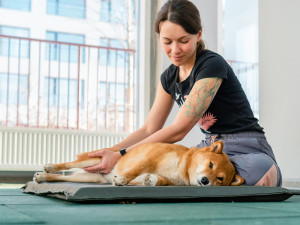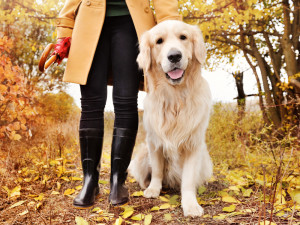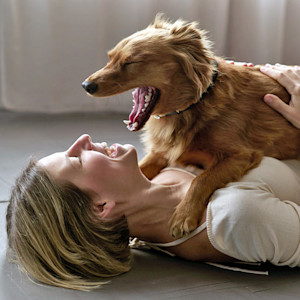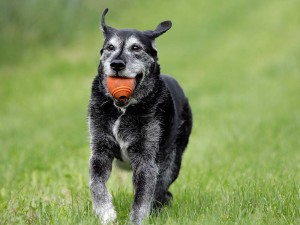Why Does My Dog Stretch So Much?
Sometimes, it’s more than just some tight muscles.

Share Article
In This Article:
Reasons Why Dogs Stretch Wanting to Play Needing More Exercise Joint Pain in Dogs Stomach Upset or Bloat Pancreatitis Boredom When to Seek Expert Help
Dogs stretch for many reasons, most of which are completely normal. They might wag, stretch, and look up at you expectantly, meaning they want to play. They’ll yawn and stretch to release muscle tension first thing in the morning and when they get up from a nap. Dogs also yawn and stretch after eating, exercising, and performing other activities throughout the day. If the stretch is accompanied by a butt wiggle, all the better.
Qiai Chong founded Pet Coach Singaporeopens in new tab and is the country’s first dog behaviorist with a master’s degree in applied animal behavior and animal welfare. Chong points to several reasons a dog may stretch: self-soothing, releasing muscle tension or discomfort, and oftentimes pandiculation — a fancy word for stretching and yawning at the same.

Snap a pic of your pup’s teeth, and GREENIES™ will help you spot potential signs of oral health issues.
“Similar to humans, dogs engage in pandiculation, which combines stretching and yawning, especially after periods of rest,” Webster Cheongopens in new tab, head coach at Pet Coach Singapore, says. “This instinctive behavior helps reset their muscular and nervous systems, preparing them for activity. Pandiculation is an essential part of a dog’s natural routine, particularly after sleeping or prolonged inactivity. The stretch itself may not necessarily feel good. What feels good is after the stretch, like with humans.”
How much do you spend on your pet per year?

Reasons why dogs stretch
There are six main reasons — ranging from perfectly normal to those requiring a vet visit — why your dog may be stretching.
1. Wanting to play
Dr. Gabre Dentonopens in new tab, pet trainer and veterinary care expert, says if your dog stretches into a play bow — front legs down, butt up — they’re probably inviting you to play. “They might do this as soon as you come in the door. “It’s their way of saying, ‘Let’s go!’” Denton says.
This play signal can be directed at you or another dog. It’s a non-threatening gesture that conveys peaceful intentions. You might notice it when dogs meet each other for the first time. Usually, it’s accompanied by an open mouth, wagging tail, and comical butt dance. When you see this type of stretch, jump into a play session if you can, because your dog’s in the mood for fun. They’ll bounce around like maniacs, resuming the play bow at intervals to let you know they’re ecstatic.
2. Needing more exercise
If your dog keeps stretching and yawning, they may need to release some energy. Like humans, all dogs need daily exercise. Some need more than others depending on their breed and age, but consider it necessary for both of you to walk at least once a day. Denton says dogs stretch to loosen up, especially if they’ve been lying around too much. “If yours is stretching a lot, they might need more walks or playtime,” he says.
Cheong, who specializes in canine fitness, says dogs stretch instinctively to relieve muscle tension or discomfort, much like humans stretch to ease tightness. “This is particularly noticeable after vigorous exercise or prolonged inactivity, helping dogs regain comfort and mobility,” he says. “Stretching in this context serves as a functional way to prepare their muscles for movement or relaxation after physical strain.”
Exercise prompts instinctive stretching that supports muscle flexibility and enhances blood circulation. “This helps maintain a healthy range of motion and prevents stiffness,” he says.
If your dog goes long periods of time between walks and bouts of activity, set up an indoor environment with distractions, such as a puzzle feeder at the top of the stairs, a doggie door to an enclosed outdoor yard, a stuffed Kong, or a long-lasting chew toy. Some dog parents swear by TV for dogs with outdoor scenes and relaxing music.
3. Joint pain in dogs
Joint pain and arthritis become common as dogs age, and occur even sooner in dogs who are overweight or have orthopedic conditions. If you suspect your dog is stretching more due to joint pain, look for accompanying behavior such as decreased energy levels, stiffness and difficulty climbing stairs, jumping on furniture and getting in the car, increased panting, and limping. “Frequent stretching, especially with stiffness or hesitation to move, can mean achy joints. Arthritis or early joint issues could be at play,” Denton says.
Your vet can check for pain and swelling, assess mobility, and take X-rays to diagnose arthritis and joint disease. Fortunately, there are a lot of options for dog arthritis pain management. Your vet may prescribe medication to treat joint pain and recommend joint injections or supplements such as fish oil or glucosamine. At home, spend time outdoors in the sun to stimulate the production of Vitamin D. Go for more frequent, shorter walks and learn to stretch-massage your dog to keep muscles supple and boost circulation.
4. Stomach upset or bloat
A dog stretching into a prayer position (front down, bottom up) could be trying to ease belly discomfort, Denton says. Gastric dilatation-volvulus (GDV), also known as bloat or twisted stomach, is a very serious condition in dogs that can result in death. It occurs primarily in large, deep-chested dogs. Look for stretching accompanied by gagging and retching, a visibly distended stomach that’s tender to the touch, shock, and difficulty breathing. Call your vet immediately if you see any of these signs. “If they seem restless, bloated, or in pain, it’s worth a vet visit,” Denton says.
5. Pancreatitis
Dogs vomit for all sorts of reasons that can be innocuous (like snacking on grass), but this can also mean something is seriously wrong. If your dog is stretching a lot and vomiting, refusing food, and looking really uncomfortable, Denton says they could have pancreatiti s. “That needs quick vet care,” he says.
The pancreas is a vital organ on the right side of the abdomen that produces enzymes to help digest food as well as hormones (such as insulin) to regulate blood sugar and glucose metabolism. Pancreatitis occurs when the pancreas becomes inflamed. It’s common in dogs and doesn’t account for age, sex, or breed. It can be acute or chronic, and it’s often — but not always — caused by a dog eating a lot of high-fat food at once (so don’t ever leave out that pan of Thanksgiving turkey drippings where your dog can reach it).
6. Boredom
Denton says sometimes a stretch is just a stretch — or a sign your dog needs something to do. “If they’re stretching a ton but seem fine, try adding more play or mental stimulation,” he says.
Boredom creates stress because dogs lacking exercise and mental stimulation can become anxious. Look for stretching accompanied by yawning, which is a subtle early sign of stress. Just like the dog who needs more exercise (see above), a bored dog needs distractions such as enrichment toys, a stuffed Kong, or long-lasting chew toys. Chong says dogs may stretch as a self-soothing behavior in response to stress or anxiety.
“While less common than other stress-related signals like yawning, lip licking, or shaking off, stretching can still be an indicator of discomfort,” she says. “If your dog typically does not stretch often but begins doing so in response to a specific stimulus, it may be a subtle sign of stress. This change in behavior should not be overlooked, as it may provide valuable insight into your dog’s emotional state.”
When to seek expert help
If frequent stretching is accompanied by dramatic symptoms, call your vet immediately. These signs may include vomiting, diarrhea, difficulty breathing, abdominal tenderness, fever, and signs of shock.
Bottom line
Stretching is mostly an innocuous way for dogs to release muscle tension when they get up from a nap. Pandiculation, or stretching and yawning at the same time, helps them reset their nervous system.
A lot of times, stretching means a dog wants to play.
Sometimes stretching can be a sign of joint pain. But when it’s accompanied by vomiting, diarrhea, and bloating, it could signal an emergency, such as pancreatitis or a twisted stomach.
FAQs
Why does my dog stretch?
Dogs stretch to release muscle tension, self-soothe, and communicate their desire to play. Pandiculation, or stretching and yawning simultaneously, is an instinctive behavior that helps dogs reset their muscular and nervous systems, preparing them for activity. Stretching can also be a sign of boredom or lack of exercise. More serious reasons for stretching include emergency health issues such as pancreatitis and bloat.
Is stretching good for my dog?
Yes, dogs stretch to relieve muscle tension and reset their nervous system before and after activities, which feels good.
When should I be concerned that my dog is stretching a lot?
Frequent stretching may indicate joint pain and arthritis, which is common in dogs of all ages and requires veterinary attention. But head to the vet immediately if the stretching is accompanied by a tender, distended stomach, gagging, difficulty breathing, or vomiting — which may indicate a twisted stomach or pancreatitis.
How can I tell if my dog has a bloated stomach?
You can tell your dog has bloated stomach, because their stomach will be distended and tender to the touch. They may also have a fever. The onset of a bloated or twisted stomach can be sudden. Anxiety, pacing, an inability to get comfortable, and restlessly moving around the house are other signs of a bloated stomach and require immediate veterinary attention.
What are the signs of pancreatitis in dogs?
Your dog will have a hunched back, vomiting, and diarrhea. Lethargy and lack of appetite are other signs of pancreatitis, which is an emergency.
References
“Arthritis Management and Prevention.” Veterinary Teaching Hospital, vetmedbiosci.colostate.edu/vth/services/orthopedic-medicine/arthritis-management-and-preventionopens in new tab.
“Bloat or Gastric Dilatation-Volvulus (GDV)» Small Animal Hospital» College of Veterinary Medicine» University of Florida.” Ufl.edu, 2024, smallanimal.vethospital.ufl.edu/clinical-services/emergency-critical-care/bloat-or-gastric-dilatation-volvulus-gdvopens in new tab.
College, Community Care. “K9-Mysteries.” Community Care College, 15 Mar. 2017, communitycarecollege.edu/veterinary-assistant/pet-behavior/k-9-behaviorsopens in new tab.
“Exercise - Canine Welfare Science.” Canine Welfare Science, 11 July 2023, caninewelfare.centers.purdue.edu/behavior/exerciseopens in new tab.
“How to Fight Fido’s Boredom When It’s Too Hot for Walks | University of Arizona News.” Arizona.edu, 2022, news.arizona.edu/news/how-fight-fidos-boredom-when-its-too-hot-walksopens in new tab.
Hunter, Tammy. “Pancreatitis in Dogs.” Vca_corporate, vcahospitals.com/know-your-pet/pancreatitis-in-dogsopens in new tab.
Marciano, Nicole. “Acute Pancreatitis in Dogs.” 2018, https://www.vetmed.msstate.eduopens in new tab.
Willard, Michael. “Canine Acute Pancreatitis.” Auburn University College of Veterinary Medicine, www.vetmed.auburn.edu, www.vetmed.auburn.edu/wp-content/uploads/2018/09/Canine-Acute-Pancreatitis-.pdfopens in new tab.
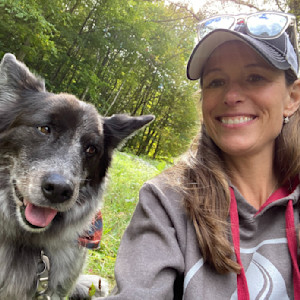
Catherine Fahy Green
Catherine Fahy Green is a journalist turned copy and content writer. As a pets writer, she focuses on and is fascinated by animal body language because there's so much to learn from and about animals by spending time in their presence and observing their physical cues.
Her work as a PR specialist appears in national trade media as press releases and stories about exciting new products people should try. She lives with her family in Western Massachusetts, where she listens closely to the stories her two dogs, flock of chickens, and four horses tell her. She spends her weekends at horse shows with her daughter.
Related articles
![Happy golden retriever dog on a walk with owner in woodsy yellow and orange fall setting with leaves on the dirt trail.]()
Home Remedies for Dog Joint Pain Relief
DIY ways to help your pup cope with the pain.
![Poodle sitting next to the girl while having home yoga class]()
So You Want to Try Doga?
Nope, that’s not a typo — dog yoga can improve the mental well-being of people and their pets. They don’t call it downward dog for nothing!
![Dog yawning at home with owner.]()
Why Does My Dog Yawn So Much?
Reasons aside, it’s pretty darn cute.
![Older dog playing with ball in a green field]()
Dog Arthritis Treatment: How to Relieve Arthritis Pain in Dogs
Tips for treating achy joints — from medications to massages.
![Shiba inu dog sleeping in bed]()
My Dog Sleeps All Day—Is That Normal?
Dogs need more sleep than humans. Here’s how much is healthy.

